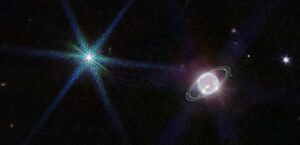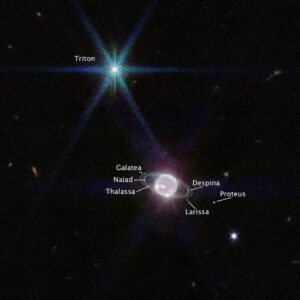Neptune, the eighth and farthest planet from the Sun, is not only a beautiful blue world, but also a mysterious one.
It has a complex system of rings and moons that has fascinated astronomers for decades. However, observing Neptune from Earth is challenging due to its great distance and dimness. That’s why the recent image of Neptune captured by NASA’s James Webb Space Telescope (JWST) is so remarkable.
JWST is the most powerful and advanced space telescope ever built. It was launched in December 2021 and reached its final orbit at the second Lagrange point (L2), about 1.5 million kilometers from Earth, in January 2022. Since then, it has been undergoing a series of tests and calibrations to prepare for its main mission: to explore the origins of the universe and the formation of galaxies, stars, planets, and life.
As part of its commissioning phase, JWST turned its Near-Infrared Camera (NIRCam) toward Neptune last year. The result was a stunning portrait of the ice giant and its surroundings. Not only did JWST capture the clearest view of Neptune’s rings in more than 30 years, but it also revealed new details of the planet’s atmosphere and moons.
Neptune’s rings are composed of dust and debris that orbit the planet at various distances and angles. They are very faint and difficult to detect from Earth, especially compared to the more prominent rings of Saturn or Uranus. Some of Neptune’s rings were first discovered in 1984 by ground-based observations, but they were only fully revealed by NASA’s Voyager 2 spacecraft during its flyby in 1989.
Since then, no other spacecraft or telescope has been able to capture such a crisp view of Neptune’s rings as JWST did. The new image shows several bright, narrow rings, as well as fainter dust bands that extend outward from the main rings. These dust bands are thought to be produced by collisions or interactions between Neptune’s moons and ring particles.
“It has been three decades since we last saw these faint, dusty rings, and this is the first time we’ve seen them in the infrared,” said Heidi Hammel, a Neptune system expert and interdisciplinary scientist for JWST.
JWST’s extremely stable and precise image quality allows these very faint rings to be detected so close to Neptune. The telescope also has a much larger mirror than any previous space telescope, which enables it to collect more light and resolve smaller features.
In addition to the rings, JWST also captured seven of Neptune’s 14 known moons: Galatea, Naiad, Thalassa, Despina, Proteus, Larissa, and Triton. Triton is the largest and most unusual moon of Neptune. It orbits in the opposite direction of the planet’s rotation and has a thin atmosphere and a frozen surface with geysers and volcanoes. Triton dominates the JWST image as a very bright point of light with diffraction spikes.
Neptune itself appears surprisingly dark in the JWST image because it is observed in near-infrared wavelengths (0.6 to 5 microns), where methane gas strongly absorbs light. Methane is one of the main components of Neptune’s atmosphere, along with hydrogen and helium. It gives Neptune its characteristic blue color in visible light images, such as those taken by the Hubble Space Telescope.
However, in near-infrared light, Neptune looks almost black, except where high-altitude clouds are present. These clouds are made of methane ice crystals that reflect sunlight before it is absorbed by methane gas. They appear as bright streaks and spots on Neptune’s disk in the JWST image.
The new image of Neptune demonstrates JWST’s capabilities to observe objects in our own solar system with unprecedented clarity and sensitivity. It also provides new insights into the dynamics and evolution of this distant world and its companions.
“Neptune is a fascinating planet that we still have much to learn about,” said Hammel. “JWST will help us uncover some of its secrets and mysteries.”



